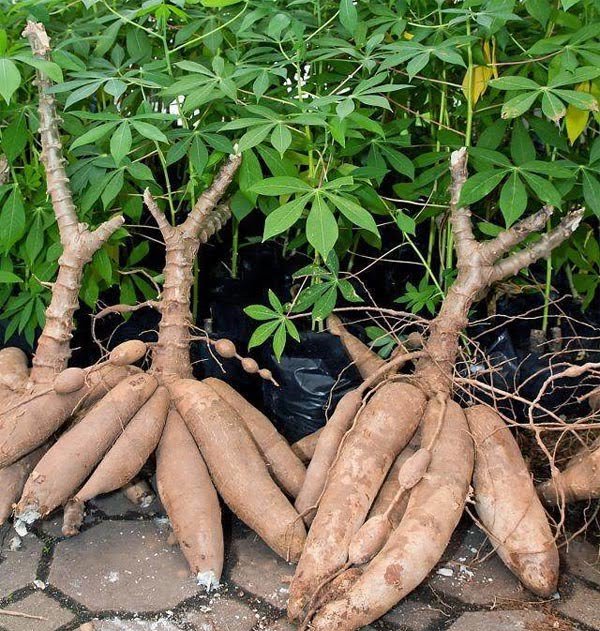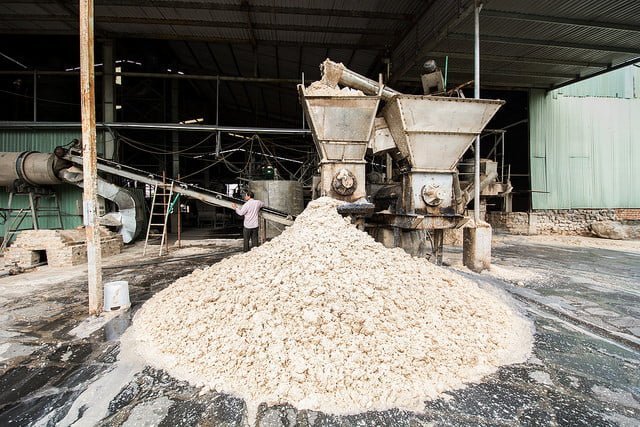The market for processed cassava is experiencing upward trends, fueled by its diverse applications, nutritional benefits, and increasing demand across food, beverage, and industrial sectors, with optimistic growth projections expected in the foreseeable future.
Cassava’s Time to Shine: A Look at Market Trends and Growth Projections for this Versatile Crop
Cassava, also known as manioc or yuca, is a starchy root vegetable that is native to South America. It is believed to have originated in the Amazon basin and was cultivated by indigenous peoples for thousands of years. Today, cassava is grown and consumed in many parts of the world, particularly in tropical and subtropical regions.
Cassava is an important crop in agriculture and food production due to its versatility and resilience. It is a staple food for millions of people, especially in Africa, Asia, and Latin America. The plant is highly adaptable to different soil and climatic conditions, making it a reliable source of food in areas where other crops may struggle to grow.
The Global Market for Cassava: An Overview
Cassava is one of the most widely grown crops in the world, with global production reaching over 280 million tons in 2020. The largest producers of cassava are Nigeria, Thailand, Indonesia, Brazil, and the Democratic Republic of Congo. These countries account for more than 60% of global cassava production.
In terms of consumption, Africa is the largest consumer of cassava, followed by Asia and Latin America. Cassava plays a crucial role in food security in many developing countries, where it provides a cheap source of calories and nutrients for millions of people. However, the global market for cassava faces several challenges, including low productivity, post-harvest losses, and limited value addition.
Cassava’s Nutritional Value and Health Benefits
Cassava is a rich source of carbohydrates and provides energy for the body. It also contains small amounts of protein, vitamins, and minerals. However, cassava is relatively low in essential nutrients such as vitamin C, iron, and zinc compared to other staple crops like rice or wheat.
| Nutrient | Amount per 100g (cooked) | Daily Value (DV) % |
|---|---|---|
| Calories | 165 kcal | 8% |
| Carbohydrates | 39 g | 13% |
| Fiber | 1.9 g | 7% |
| Protein | 1.4 g | 3% |
| Fat | 0.3 g | <1% |
| Sugars | 1.8 g | 4% |
| Vitamin C | 20.6 mg | 34% |
| Potassium | 271 mg | 6% |
| Magnesium | 22 mg | 5% |
| Phosphorus | 43 mg | 5% |
| Manganese | 0.5 mg | 23% |
Despite its limited nutrient content, cassava has several health benefits. It is gluten-free, making it suitable for people with celiac disease or gluten intolerance. Cassava also contains dietary fiber, which can promote digestive health and prevent constipation. Additionally, cassava contains antioxidants that can help protect the body against oxidative stress and chronic diseases.
There is also growing interest in using cassava in functional foods and supplements. Researchers are exploring ways to enhance the nutritional value of cassava by fortifying it with vitamins and minerals. Cassava-based products such as flour, starch, and chips are being used as ingredients in the food industry to improve the nutritional profile of processed foods.
The Role of Cassava in Food Security and Poverty Alleviation
Cassava plays a critical role in ensuring food security in many developing countries, particularly in sub-Saharan Africa. It is a drought-tolerant crop that can withstand harsh growing conditions, making it a reliable source of food during periods of drought or other climate-related disasters.
Cassava farming and processing also provide economic opportunities for smallholder farmers and rural communities. The crop has a short growing cycle, allowing farmers to harvest it within 6 to 12 months. This provides a quick source of income for farmers and helps alleviate poverty in rural areas.
Furthermore, cassava processing activities such as drying, milling, and starch extraction create jobs and stimulate local economies. In some countries, cassava processing has become an important source of income for women entrepreneurs, empowering them economically and socially.
However, there are challenges in promoting cassava as a poverty alleviation crop. These include limited access to markets, lack of infrastructure for processing and storage, and low productivity due to pests and diseases. Addressing these challenges requires investments in research and development, as well as supportive policies that promote value addition and market access for smallholder farmers.
Cassava’s Growing Popularity in the Food Industry
Cassava is increasingly being used in the food industry due to its versatility and functional properties. It can be processed into various forms such as flour, starch, and chips, which can be used as ingredients in a wide range of food products.
One of the main applications of cassava in the food industry is as a gluten-free alternative to wheat flour. Cassava flour can be used to make bread, cakes, and other baked goods that are suitable for people with gluten intolerance or celiac disease. Cassava starch is also used as a thickening agent in soups, sauces, and other processed foods.
Consumer trends and preferences are also driving the demand for cassava-based products. There is a growing interest in natural and plant-based foods, and cassava fits into this trend as a sustainable and nutritious crop. Consumers are also looking for healthier alternatives to traditional snacks and processed foods, and cassava chips offer a gluten-free and lower-fat option.
The food industry is also investing in innovation and product development to create new cassava-based products. This includes developing fortified cassava flour with added vitamins and minerals, as well as creating new snack products using cassava chips. These innovations not only cater to consumer preferences but also contribute to improving the nutritional value of processed foods.
Cassava Processing and Value-Added Products
Cassava can be processed using both traditional and modern methods. Traditional processing methods include peeling, grating, fermenting, and drying the roots to produce flour or chips. Modern processing techniques involve mechanical extraction of starch from the roots using machines.
Value-added products from cassava include cassava flour, starch, chips, and pellets. Cassava flour is used as a substitute for wheat flour in baking, while cassava starch is used as a thickening agent in various food products. Cassava chips are consumed as snacks or used as ingredients in the food industry. Cassava pellets are used as animal feed.
The market demand for cassava-based products is growing, driven by the increasing popularity of gluten-free and natural foods. Cassava flour and starch are used in the production of gluten-free bread, pasta, and other baked goods. Cassava chips are marketed as a healthier alternative to potato chips, appealing to health-conscious consumers.
There is also potential for value addition in the cassava industry. For example, cassava waste can be used to produce biofuels or animal feed, reducing waste and creating additional revenue streams. Research and development efforts are focused on finding innovative uses for cassava by-products and improving the efficiency of processing techniques.
The Impact of Climate Change on Cassava Production
Climate change poses significant challenges to cassava production. Rising temperatures, changes in rainfall patterns, and increased incidence of pests and diseases can negatively affect cassava yield and quality.
Cassava is a tropical crop that requires a warm and humid climate to grow. However, extreme heat can reduce photosynthesis and slow down plant growth. Changes in rainfall patterns can also lead to drought or flooding, which can affect cassava root development and yield.
Pests and diseases are another major concern for cassava farmers. The most devastating pest is the cassava mealybug, which can cause significant yield losses if not controlled. Other pests include whiteflies, spider mites, and nematodes. Cassava mosaic disease and cassava brown streak disease are viral diseases that can also reduce yield and quality.
To adapt to climate change, cassava farmers and processors need to implement strategies to mitigate the impact of climate change. This includes using drought-tolerant varieties, improving water management practices, implementing pest control measures, and diversifying crops to reduce dependence on cassava.
Research and development initiatives are also underway to develop climate-resilient cassava varieties through breeding programs. These efforts aim to develop varieties that are more tolerant to heat, drought, and pests, ensuring the long-term sustainability of cassava production.
Cassava’s Potential as a Biofuel Crop
Cassava has gained attention as a potential feedstock for biofuel production. The crop has a high starch content, which can be converted into ethanol through fermentation. Ethanol produced from cassava can be used as a renewable fuel for vehicles or as an additive to gasoline.
Using cassava as a biofuel feedstock has several advantages. It is a renewable and sustainable source of energy that can reduce dependence on fossil fuels. Cassava is also a low-input crop that requires minimal fertilizers and pesticides, making it an environmentally friendly option.
However, there are challenges in using cassava as a biofuel crop. The main concern is the potential competition between food and fuel production. If large-scale cassava cultivation for biofuels displaces food crops, it could lead to food shortages and higher prices, particularly in developing countries where cassava is a staple food.
Another challenge is the environmental impact of cassava biofuel production. The cultivation of cassava requires large amounts of water and can lead to soil erosion if not managed properly. Additionally, the processing of cassava into ethanol requires energy and water, which can have negative environmental consequences if not done sustainably.
Government Policies and Investments in Cassava Production
Governments and international organizations play a crucial role in supporting cassava farming and processing through policies and investments. Many countries have implemented policies to promote cassava production, such as providing subsidies for inputs, improving access to credit, and investing in infrastructure for processing and storage.
International organizations such as the Food and Agriculture Organization (FAO) and the International Fund for Agricultural Development (IFAD) also provide technical assistance and funding for cassava research and development projects. These initiatives aim to improve productivity, quality, and market access for smallholder farmers.
Public-private partnerships are also important in promoting cassava production and value addition. Private sector investments in research and development, processing facilities, and marketing can help create a more sustainable and competitive cassava industry. Collaboration between governments, research institutions, and the private sector can lead to innovation and technology transfer, benefiting all stakeholders in the cassava value chain.
Challenges and Opportunities in Cassava Farming and Marketing
Despite its potential, cassava production and marketing face several challenges. Low productivity is a major constraint, particularly in smallholder farming systems where farmers lack access to improved varieties, fertilizers, and other inputs. Pests and diseases also pose a significant threat to cassava production, requiring effective control measures.
Market access is another challenge for cassava farmers. Limited infrastructure for transportation and storage can result in post-harvest losses and reduce the quality of cassava roots. Additionally, cassava faces competition from other crops such as maize or rice, which are often preferred by consumers.
To address these challenges, strategies for improving cassava productivity, quality, and marketability are needed. This includes promoting the use of improved varieties that are resistant to pests and diseases, providing training and extension services to farmers, and investing in infrastructure for processing and storage.
There are also opportunities for smallholder farmers and women entrepreneurs in the cassava value chain. Small-scale processing activities such as drying or milling can provide additional income for farmers. Women entrepreneurs can also play a significant role in adding value to cassava products through processing and marketing activities.
Future Outlook: Growth Projections and Market Trends for Cassava
The future outlook for the global cassava market is promising, with forecasts projecting continued growth in production, consumption, and trade. The increasing demand for gluten-free and natural foods is expected to drive the demand for cassava-based products.
Emerging trends in the global cassava market include the development of fortified cassava products with added vitamins and minerals. There is also growing interest in using cassava waste for biofuel production or as a source of animal feed. These trends present opportunities for innovation and value addition in the cassava industry.
The implications of these trends for stakeholders in the cassava industry are significant. Farmers and processors need to adapt to changing consumer preferences and invest in technologies that improve productivity and quality. Governments and international organizations need to continue supporting research and development initiatives that promote sustainable cassava production and value addition.
In conclusion, cassava is a versatile crop with significant importance in agriculture and food production. It provides a cheap source of calories and nutrients, contributes to food security, and offers economic opportunities for smallholder farmers and rural communities.
The global market for cassava is growing, driven by consumer trends and preferences for gluten-free and natural foods. However, there are challenges in promoting cassava production and value addition, including low productivity, post-harvest losses, and limited market access. Addressing these challenges requires investments in research and development, supportive policies, and collaboration between stakeholders in the cassava value chain.
Originally posted 2024-04-02 12:56:01.



